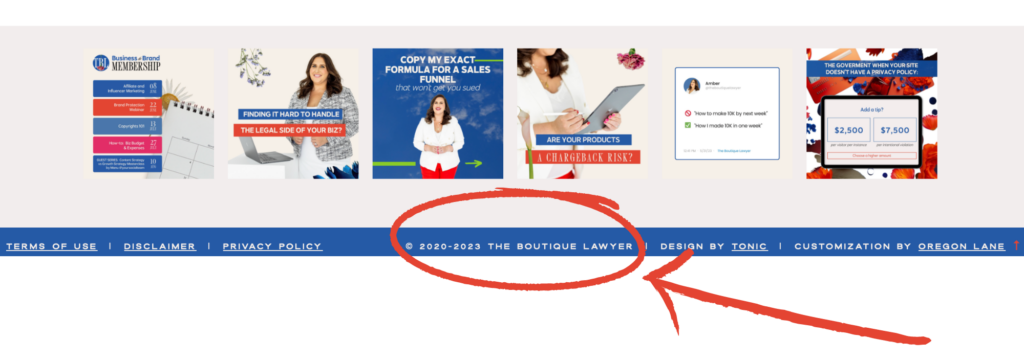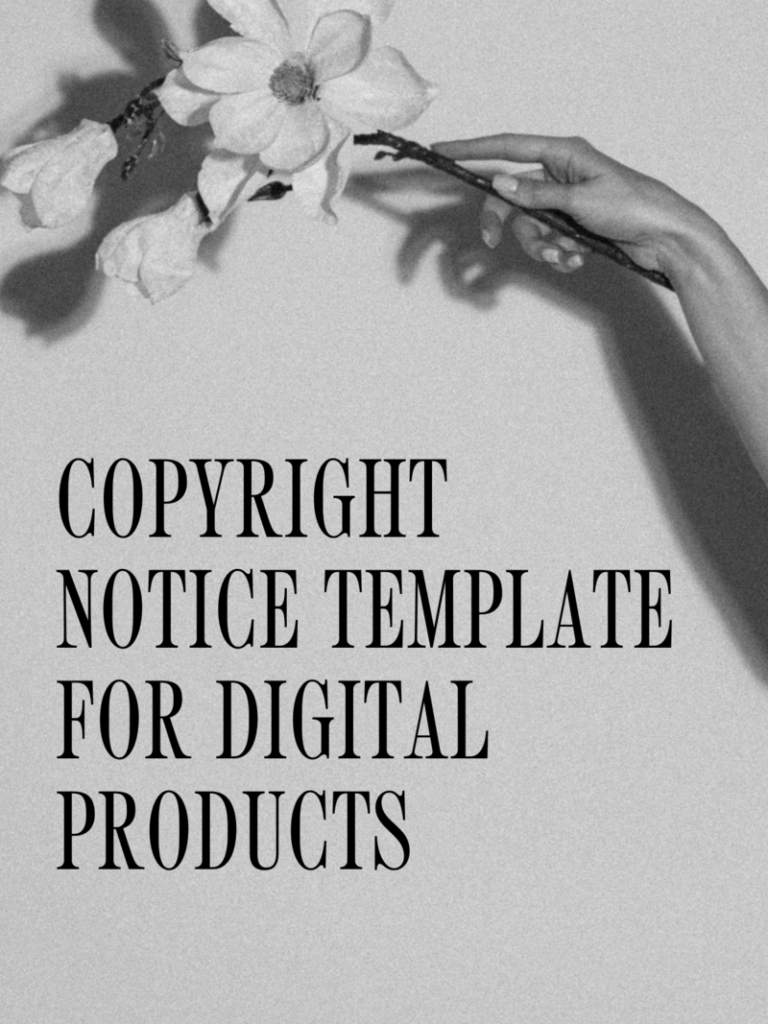It’s a pretty well known fact that if you have a website, then at the bare minimum you need to include a copyright notice in the footer of that site.
Any website developer or designer will tell you this and even if you’re new to the online world, it’s a pretty common thing to know.
If you’re unfamiliar, a copyright notice looks like this:

Mine reads “© 2020-2023 The Boutique Lawyer.”
The standard copyright notice always includes the Circle C (©), the first year you published your website and the last year it was updated followed by your legal business name.
Most people know that they need this notice on their website to tell users that your site and work is protected by copyright and you have the rights to the content.
While this is a well known fact, did you know that you also need to display a copyright notice on ALL of your digital assets?!
As a business owner, there’s a good chance that you’re doing a lot of creating and offering a ton of value to your audience in the form of freebies.
Maybe you’re creating free guides that can be downloaded, offering free trainings that people can opt in to or have some other form of tangible lead magnet in exchange for their email address.
If this is the case for you, you should know that ALL of that content needs its very own copyright notices in order to give you maximum protection from copyright infringement and tell users what they can and can not do with your content.
Without putting a copyright notice on all of these assets, you have no real protection against someone stealing your stuff.
So, to save you from that horrible headache, let’s dive into what exactly copyright is, why it matters so much and what assets you need to include the notice.
What is a Copyright Notice?
First and foremost, what even is a copyright notice?
The copyright symbol (©) likely looks familiar to you and you probably know that it’s an important legality for your business, but you may not fully understand what it is.
Put simply, a copyright notice is a statement placed on a piece of work to inform the public that the work is protected by copyright.
As mentioned above, it typically includes the copyright symbol (©), the year you first published the piece of work and the year it was last updated, followed by the name of the copyright owner, brand or business.
The main purpose of a copyright notice is to provide notice to others that the work is protected by copyright and to assert the rights of you, the copyright owner.
You may be wondering if protecting your digital assets from being stolen is really that simple…
All you have to do is put this notice on the things you create and you’re golden?! ✨
Well, it’s important to note that the copyright notice doesn’t automatically afford you copyright registration.
Copyright notice and copyright registration are two different things, but including a notice is the FIRST step in all of this because it gives people a❗️WARNING❗️ that essentially says, “hey! I’m claiming the rights to this, so if you infringe my stuff, you’re doing it willfully.”
We’ll talk more on what “willful infringement” means in just a second, but for now let’s talk a bit more about the difference between Copyright Notice and Registered Copyright!
Copyright Notice VS. Registered Copyright
Now that you’re clear on what a copyright notice is, you might be wondering what the difference between a simple notice and a registered copyright is.
Essentially, a registered copyright is a copyright that has been officially registered with the government and provides the real protection that you would need in the instance that someone does steal your stuff.
Copyright registration is a legal process where you as the business owner submits an application and accompanying materials to the copyright office to obtain a formal registration of their copyright.
When a copyright is registered, you receive a registration certificate or a registration number from the copyright office, which serves as evidence of the registration.
In the instance that someone has or is stealing your content (whether it be from your website, lead magnet, course, etc.) where a copyright notice has been included, you would then need to officially register your copyright with the government in order to seek a claim for copyright infringement.
Ultimately, copyright IS automatic whenever you publish your work or content, which means that you DO have rights to the content, but official registration is not automatic.
Why You Need to Include a Copyright Notice on Your Digital Assets
Now, back to why all of this matters so much.
As a business owner, you spend a lot of your time, money, energy and resources on creating great work and the last thing you want is for someone to steal what you do and claim it as their own.
For example, let’s say you spend months creating a course for your business, you sell it to your email list and a few weeks later you realize that one of your students is using the course contents to create something of their own.
That would be the WORST feeling, right?!
Well, IF you include a copyright notice on ALL of your course materials, including workbooks, slide decks, training videos and additional course resources, you would have the ability to claim copyright infringement and go after the student legally.
This is where that “willful infringement” I mentioned earlier comes in!
If you provide a copyright notice on your assets and someone does steal the content, that means they’re doing it willfully, which means YOU are entitled to greater damages (aka you can take real legal action and it could cost them big time).
WITHOUT including that copyright notice on your course materials, proving that the person stealing your work knew it was yours and not in the public domain or “fair use” (topic for another time), now becomes another element that you have to prove: meaning more work for you.
As a lawyer and as a business owner, there’s fewer things that fire me up more than people stealing someone else’s work and getting away with it, which is why I’ve made it my personal mission to make the legalities of business SUPER SIMPLE for you!
In The Boutique Lawyer contract shop, you can find almost every possible contract or legal agreement you need for your online business and the best part is that you don’t have to do all of the legal research yourself.
It’s all been done for you by someone who feels comfortable using legal jargon in their everyday life (and no I’m not talking about Elle Woods – it’s me!), so you can grab what you need, download the template and plug in your specific business details!
It’s truly never been easier (or more affordable) to give your business the legal leg up that it deserves. 🎉
FREE TEMPLATE: Copyright Notice Template for Digital Goods
Protect your digital assets… like a lawyer! Click the button below to get our FREE Copyright Notice Template

For copyright specifically, it’s even more simple than that – simply use the formula below to display on your website and other digital assets to start protecting your business or brand TODAY.
COPYRIGHT NOTICE FORMULA: © [INSERT FIRST YEAR OF PUBLICATION] – [INSERT YEAR IT WAS LAST UPDATED] [INSERT LEGAL BUSINESS NAME].
SAMPLE COPYRIGHT NOTICE STATEMENT: This resource is protected by copyright laws and international treaties. Unauthorized reproduction or distribution of this resource, or any portion thereof, may result in severe civil and criminal penalties, and will be prosecuted to the maximum extent possible under the law.
For all other legal needs, head to my contract shop – and if you can’t find what your business needs, send me a DM here! We’re constantly creating new resources to serve you best.
Where to Include a Copyright Notice
Lastly, let’s quickly touch on where exactly this copyright notice needs to be.
Throughout this blog post, I’ve been saying ALL digital assets and I really do mean that, but in case you’re wondering what exactly that entails for online business owners specifically, here’s a quick list for you:
- Your website and website content
- Lead magnets
- Books and downloadable E-books
- Free guides
- Templates
- Slide decks
- Workbooks
- Course materials
Essentially, any type of digital asset or digital product that’s paid OR free needs to have a copyright notice. And when in doubt, always include one because you’d rather be safe than sorry!
Here’s to legally protecting your stuff – it’s not as hard as you might think. 🥂
